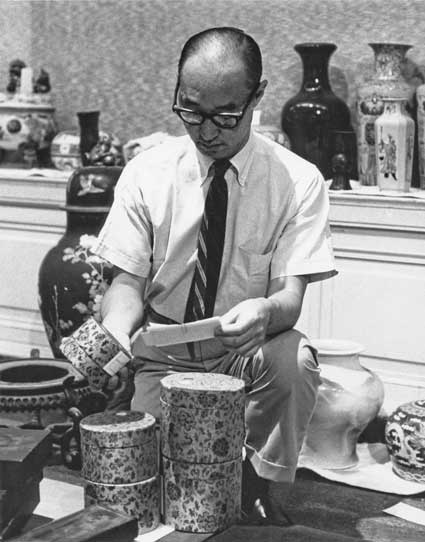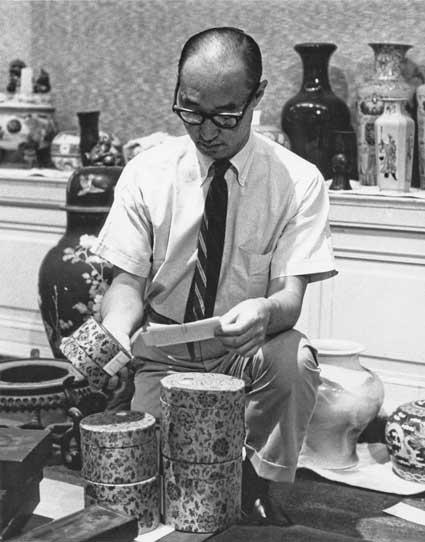In connection with its archive program, LACMA has been conducting oral history interviews with ex-staff and volunteers. One of the most exciting biographical interviews has come from former Senior Curator of Far Eastern Art George Kuwayama.
While studying Chinese paintings and ceramics on a fellowship at the National Palace Museum, Taiwan, George was invited to join the curatorial staff at the Los Angeles County Museum of History, Science and Art at Exposition Park for what was then known as the “Oriental Art” Department. Throughout his nearly forty-year career, George secured numerous acquisitions, greatly enriching the museum’s holdings in Japanese, Chinese, Korean, and Indian art, and began the initiative to create the Pavilion for Japanese Art. He was also responsible for organizing many important exhibitions such as Art Treasures from Japan and The Quest for Eternity: Chinese Sculpture from the People’s Republic of China.

George Kuwayama
Like many art historians studying Sino-Japanese art during the mid-twentieth century, George’s earliest research played out against the backdrop of historical drama. In our interview he spoke of his frustrating attempts to access artworks in war-torn Japan in the early 1950s. He also described at length a subsequent experience, examining Chinese masterpieces spirited away from the country during Chiang Kai-Shek’s retreat from China to Taiwan.
All the artworks came from the original Palace Museum in Peking. When the Sino-Japanese war broke out, they moved Chinese treasures from Peking to the south, to Nanking. When the Japanese came up the Yangtze River, they moved westward to Suchuan, and Chungking became the capital of wartime China. The Palace treasures were stored safely in the hillside caves, and then after WWII, were brought back. But there was still fighting between the Nationalists and the Communists, so the collection was never truly unpacked, and it sat in Nanking for a while. When the Communists advanced and beat up the Nationalists, chasing them out of the Yangtze Valley, Chiang Kai-Shek decided to make a strategic retreat to Taiwan. He brought much of the Palace collection to Taiwan—a good deal of the cream of the Palace Museum’s collection.
There in the hillsides of central Taiwan, George followed a team reviewing the expatriated treasures of the centuries-old Chinese empire. He described this once-in-a-lifetime opportunity:
I was there at an ideal time because they were doing inventory and condition reports. So every day from ten till twelve and from two to four, they would unpack great works of art for examination. I’ve forgotten the exact number—about twenty paintings a session…. It was a grand experience to see close-up the supreme masterpieces of Chinese art.
Over the course of our interview, George had a number of great stories to tell, including the tale of a vacation to Mexico in the 1960s. While there he was surprised to see an antique Chinese porcelain bowl in the National Historical Museum. He asked himself, “What is this bowl doing here?” This simple question initiated an intellectual quest that would occupy him off and on for many years. Researching the Manila galleon trade of East Asian luxury goods to Latin America became a personal passion during his tenure, and especially following George’s retirement from LACMA in 1997. George uncovered how silk and porcelain traveled around the globe to satisfy European tastes in Spanish- and Portuguese-controlled territories as well as the cultural exchanges that occurred from this commerce, such as the copying of Chinese styles and motifs by local, indigenous craftsmen. Because of the complicated provenance of these objects, George substantiated his research with archeological confirmation from digs in Mexico City, Lima, and Antigua, Guatamala, as well as shipwrecks across the Pacific. George published Chinese Ceramics in Colonial Mexico in 1997 and continues to be inspired by this fascinating global artistic exchange.
George retired from LACMA in 1997, but he hasn’t retreated from historical drama. In his current study, George researches sixteenth–eighteenth century Chinese porcelain brought to the New World by the Manila galleons.
Aaron Ziolkowski, Collections Information Intern



